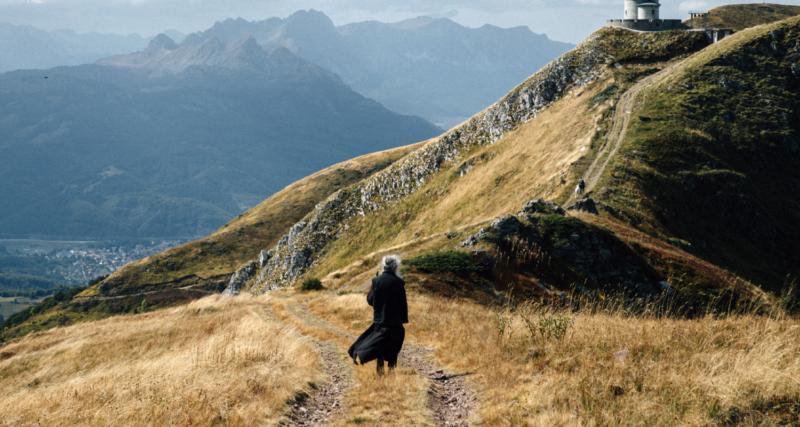
Monk ascending a mountain to pray
In our busy world many people are searching to find balance between their inner spiritual lives and their outer material ones. Pilgrimage is one way to energize our search for deeper meaning and purpose in our lives. Through pilgrimage, the spirit is renewed and our general outlook becomes uplifted, changing the way we look at everyday life. The footsteps of pilgrims have echoed continuously through the halls of time, for by visiting sacred sites we are able to immerse ourselves in their powerful vibrations and have a direct personal experience of divinity. This experience is the power of pilgrimage and why it is a major tenet of most religions.
Pilgrimage has been practiced since the sun first rose on human civilization. Before recorded history, the faithful devotees of the Indus valley, people now known as Hindus, made sacred treks to the revered sites of India. The Hindu spiritual life is a process of reaching complete union or oneness with the Divine, a state of consciousness known as samadhi, and pilgrimage has historically been a means of seeking this deep connection. Modern Hindus continue to take pilgrimage very seriously, often traveling to one of the seven sacred rivers, seven liberation-giving cities, or other spiritual sites found throughout their ancient land. For the Hindu, where one “goes” on pilgrimage is not as important as how one follows the “way of the pilgrim.” The goal is to have a personal experience of God through a life-changing encounter with the Divine and to experience God as an inner reality.
While pilgrimage in Hinduism relates to universal sacred sites and temples of the deities, the Buddhist tradition of pilgrimage is associated with the specific places important to the life of the Buddha. Following the death of the Buddha in 544 BC., the sites marking the four sacred events of his life were enshrined. These four primary sites of veneration are the birthplace of the Buddha in Lumbini, Nepal; the site of his enlightenment under the Bo Tree located in Bodh Gaya, India; the locale of his first teaching in Sarnath, India; and the place of his death, or final nirvana, in Kushinagar, India. In addition, the ashes from his funeral pyre were distributed to eight stupas, or burial mounds, throughout India, which have also become pilgrimage destinations. A Buddhist pilgrim seeks to abandon the material world and dive into a deeper understanding and assimilation of the teachings of the Buddha. The sacred journey is a means of purification and elimination of karma due to past actions, leading to enlightenment or nirvana, the ultimate goal for every Buddhist. With the blessings of the Buddha and all the great souls that pay homage at these shrines, the holy sites continue to be vibrant spots of power and enlightenment even 2500 years after the Buddha’s exit from this world.
Every aspirant in the Islamic tradition is encouraged to make a once-in-a-lifetime pilgrimage to Mecca, if physically and financially feasible. One of the seven Pillars of Islam is Hajj, or pilgrimage to the Haram mosque in the Saudi Arabian holy city of Mecca, in order to pray and commune with God. Muslims descend on Mecca from all over the globe to commune together in peace, for peace is the dominant theme of their pilgrimage. They seek peace with Allah, with their own souls, with one another, and with all living creatures.
This search for peace actually has its roots in Judaism, as the prophet Abraham and his son Ishmael originally founded the Ka’ba in Mecca two millennia before Christ. They initiated the rituals that are now an integral part of Islam. Following their inception, these rites were practiced in increasingly lower degrees of devotion until the time of the Prophet Mohammed in 622 AD. Mohammed re-introduced the importance of pilgrimage and specifically the holy significance of Hajj in Islamic life. The Hajj is a peak of religious experience for the Muslim, and over two million pilgrims partake in the rites every year. Jerusalem is also an important pilgrimage destination for followers of Islam, for The Dome of the Rock is the site of Mohammed’s ascension into heaven to commune with Allah, Abraham, Moses, Jesus and other prophets, and is said to be the place of Final Judgement.
Excerpt from Heater, James and Colleen. The Pilgrim’s Italy: A Travel Guide to the Saints. (Inner Travel Books: Nevada City, California), 2008. pages 17-19.








Leave A Comment
You must be logged in to post a comment.